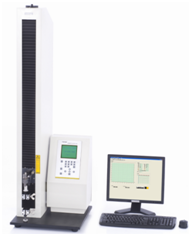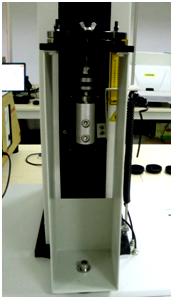Abstract: Battery separators are an indispensable part of lithium electronic batteries. The quality of separators' puncture resistance has an important impact on battery performance. This paper uses Labthink XLW (PC) intelligent electronic tensile testing machine to verify the puncture resistance of battery separator samples, and through detailed description of the verification method, test principle, equipment parameters and scope of application, monitor battery separators for enterprises For reference.
Keywords: battery separator, puncture resistance, puncture force, intelligent electronic tensile testing machine
1. Significance
With the advancement of science and technology and the enhancement of environmental awareness, lithium electronic batteries with excellent performances such as high working voltage, large energy density, long cycle life, low self-discharge rate, low pollution, and no memory effect are used in mobile phones, laptops, and tablets Computers, digital cameras, electric vehicles, aerospace, navigation, artificial satellites, small medical, military communications equipment and other products and fields are widely used. As the separator material for positive and negative electrodes, the battery separator is an essential part of the lithium electronic battery. The quality of the separator material used directly affects the safety and cost of the battery.
The puncture resistance is an important mechanical index for evaluating the performance of the diaphragm material, which can effectively reflect whether it is easy to short circuit during the diaphragm assembly process. The mixed active material, carbon black, plasticizer and PVDF are evenly coated on the metal foil, and the lithium battery electrode made after vacuum drying at high temperature is composed of tiny particles of a mixture of active material and carbon black. The unevenness of the diaphragm, so the separator material sandwiched between the positive and negative electrodes needs to withstand a lot of pressure. Therefore, the separator material should have strong puncture resistance to prevent the positive and negative electrodes of the lithium battery from contacting and short-circuiting.

Figure 1 Battery separator
2. Test basis
This verification test process is based on the relevant provisions of the puncture strength in the standard GB / T 10004-2008 "Plastic composite film for packaging, dry compounding of bags, extrusion compounding", which is applicable to dry compounding of different plastic materials Or composite film and bag made by extrusion composite process.
3. Test samples
In this paper, the common polyolefin battery separator is used as a test sample to test its puncture resistance.
4. Test equipment
This test uses the XLW (PC) intelligent electronic tensile testing machine to test the puncture force of the battery separator sample. The device is independently developed and produced by Jinan Languang Electromechanical Technology Co., Ltd.

Figure 2 XLW (PC) intelligent electronic tensile testing machine
4.1 Test principle
The level of puncture resistance is expressed by the maximum force generated during the process of puncturing the sample to be tested-puncture force. During the test, the sample is clamped in a fixed fixture, and the moving fixture equipped with a puncture needle moves toward the sample at a set speed until the sample is punctured. The moving fixture contains a force value sensor that can monitor the puncture in real time The force value during the process changes to obtain the puncture force of the sample. In addition, the fixture is also equipped with a displacement sensor for monitoring the deformation of the sample.
4.2 Device parameters
500 N, 50 N force sensors are available; according to the relevant standards, the device provides 50 mm / min, 100 mm / min, 150 mm / min, 200 mm / min, 250 mm / min, 300 mm / min, 500 mm / min seven test speeds, which can be set freely according to the requirements of the test standards; the ultra-long stroke of 1000 mm can meet the test of materials with large deformation rate; limit protection, overload protection, automatic return and power-down memory Intelligent configuration such as to ensure the safety of the user's operation; integration of seven independent test procedures such as stretching, peeling, and tearing, provides users with a variety of test items to choose from.
4.3 Scope of application
(1) This equipment can be used for the puncture resistance, tensile properties, tensile strength, tensile strength and deformation rate, tear resistance, peel strength performance, heat seal strength performance of plastic films, composite films, sheets and other materials Index test; can be used for the puncture / pulling force test of infusion bag caps, soft rubber stoppers, oral liquid caps; can be used for the unwinding force of tape, anti-pressure of plastic bottles, combination caps and opening of jelly cups, yogurt cup lid films Power and other product and packaging performance tests.
(2) This device can meet GB / T 10004, ISO 37, GB 8808, GB / T 1040.1, GB / T 1040.2, GB / T 1040.3, GB / T 1040.4, GB / T 1040.5, QB / T 2358, QB / T 1130, ASTM D 882, ASTM D 1938, ASTM D 3330 and more than 20 domestic and foreign related standards.
5. Test process
(1) Use a sampler to cut 5 samples from the surface of the battery separator sample to be tested.
(2) Set the test speed, sample name, test times and other parameter information on the equipment control software, clamp the sample in the special fixture, and install the puncture needle. Click the "test" option, the test begins, the puncture needle moves the puncture sample according to the set test speed, the device displays the force value change in real time, and reports the puncture force value at the end of the test.

Figure 3 Sample clamping diagram
(3) Repeat the sample clamping and click test operations to test the puncture force values ​​of the remaining 4 samples.
6. Test results
The puncture force test values ​​of the five samples were 5.34 N, 5.61 N, 5.57 N, 5.49 N, and 5.32 N, respectively. The puncture resistance of the battery separator samples tested was 5.47 N, the average value of the test results of the five samples.
7. Conclusion
This paper uses the XLW (PC) intelligent electronic tensile testing machine to verify the puncture resistance of the battery separator. The test process is simple, the equipment is easy to operate, and the degree of intelligence is high. The test results can truly reflect the puncture resistance of the sample. In addition to puncture resistance, the equipment used in this test can also be used to test the tensile properties of battery separators. Jinan Languang Electromechanical Technology Co., Ltd. is a high-tech enterprise specializing in the development and production of packaging inspection equipment and packaging inspection services. The equipment has served many industries and fields such as food, medicine, packaging, automotive, daily chemical, electronics, universities and third-party testing institutions. The more you understand, the more you trust! Labthink looks forward to enhancing technical communication and cooperation with enterprises and institutions in the industry.
Table Series,College Classroom Desk,Wooden Reading Table,Desks With Wheel
AU-PINY FURNITURE CO., LTD , https://www.jiangmenaupiny.com